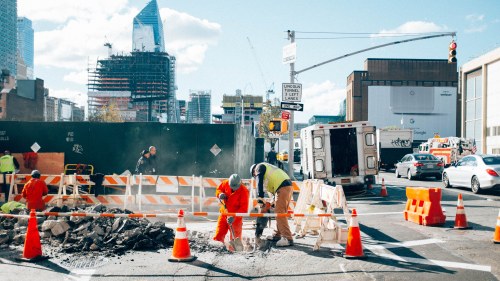How Cities Can Go Slow to Achieve Real Change

Nonresident Fellow Sascha Haselmayer discusses his new book, which synthesizes the lessons he learned from his work with cities, governments, and NGOs.
Sascha Haselmayer, a nonresident fellow at the Center on Global Cities and a senior leader at Ashoka, has worked with cities for decades to help them achieve change. He is also the founder of Citymart, an organization which helped cities radically reform their public procurement processes. In 2021, he authored a Council report outlining a democratic, citizen-focused vision for urban public procurement.
In June 2023, he published The Slow Lane: Why Quick Fixes Fail and How to Achieve Real Change, synthesizing the lessons he learned from his work with cities, governments, and NGOs in more than 50 countries.
He spoke with Samuel Kling, director of global cities research, about the book in September. This interview has been edited for length and clarity.
Samuel Kling: One of the recurring themes of the urban policy world seems to be frustration with the slow rate of change, particularly with urgent problems such as climate change. But you’re arguing that policymakers actually need to go slower. Can you explain that?
Sascha Haselmayer: This concern gets right to a fundamental tension: no one, in what I call the Slow Lane, wants things to move slowly. But these movement builders and contributors to real change have learned, often the hard way, that doing what initially feels slower when you want to solve something quickly turns out to get you to the right place faster.
Let’s start with what I call the Fast Lane: I have observed that a lot of leaders in government and business, but also at home, when faced with an urgent problem, whether big or small, are looking for a quick answer to fix that problem. And that quick answer, by default, tends to reduce the complexity of the answer. If the problem is big, we’re looking for a simple answer that is like a big sledgehammer that frees us up and solves the problem immediately. But those kinds of solutions actually end up being very risky, since you’re leaving out the things that make the problem complicated in the first place.
That’s why, when we think about these urban policy challenges, we see, for example, climate change coming closer and closer. The 2030 deadline seems to be like a cliff. We’re becoming more and more desperate as we get there, even though we’ve been trying to find quick answers to meet that deadline for 50 years already. We tend to forget that we’ve tried a lot of things already. So our impulse is to try and compress the recipes of the past, which haven’t worked, and look for that one big liberating move, that one big liberating shot at making it all go away.
Following what I learned studying a hundred movements that thrive for real change, I would argue that for those who succeed, the [real] big liberating shot is to have the nerve to let go of these quick fixes. Instead of rushing to action, they hold the urgency and take the time to actually involve the people who are going to be most affected, as well as those who already feel excluded. They listen and create a space for those who are most complicated to hear. Over and over, I have seen that unless we embrace the messiness of human conditions, make them part of the solution, we’ll lack the kind of broad alliance that will come up with, and implement a whole new set of ideas.
SK: Can you give an example?
SH: I looked at the environmental movements in Germany and the US, which were moving in parallel. In the US it soon focused very much on strategic litigation, taking battles in court. In Germany in the early 70s, the movement took a different turn. They decided that to get things done, they needed to become a political movement. The Green Party was born. One feature of the movement was that it was very diverse in its makeup, from families to left wing radicals, to conservative landscape conservationists.
They had to find new ways to organize when there was no trust and instituted new, participatory forms of governance. Now, as we look back, this movement has not only fought for climate policies. It also contributed for 50 years to rebuild Germany’s democracy, introducing new ways to deal with new issues like climate. The Green Party became the third major political force in what was mostly a two-party system forged in the industrial age. The decision to become a political movement that relies on the participation of many gave us the political setup to deal with climate change.
I think that in the US we missed that opportunity by delegating action to experts in the hope of accruing the quickest, biggest wins to achieve change. Litigation and big policy moves are amazing short-term levers to pull, just look at the gigantic infrastructure bill. But they didn’t build the long-term foundation that makes the political system ready to achieve real change on the chronic challenges that divide us. So, for me, those are examples of how this slow approach—taking a more tedious path—can lay the foundation for something much more important later.
SK: One thought that kept coming to my mind when reading your book was about the moment at the beginning of the pandemic when everything shut down. One of the ideas repeated in the urban policy world during that time—and many places, really—was the notion that this crisis was an opportunity to make transformative, positive change. The pandemic exposed inequities and now we had to fix them, and this moment was our once-in-a-generation window of possibility. I wonder what you make of that line of thinking, and now, three years later, how you think it panned out.
SH: There were so many times when I was blown away by what was possible and what happened at the beginning of the pandemic. But I would also say that certainly in the places I’ve touched and been to, most of those actions have been undone. Very little of it actually was carried over.
One of the stories I found most extraordinary was when the pandemic started. I had my children in the New York City public school system, and when they shut down the schools from one day to another, they stood up an entirely new education system, a food supply system to vulnerable children and families, and equipped, I believe, 360,000 children with iPads they had procured virtually overnight.1
I think what made this extraordinary response possible in such a huge school system--in such a huge bureaucracy with so many problems—was that over the past decades, those involved in the New York City public school system reached a shared understanding of who is most vulnerable. And not just the school system, but families and everyone else involved. They figured out what those vulnerabilities are and understood immediately what mattered most.
The school system continued to provide meals to thousands of children who depended on it. Quickly, teachers also realized that a big purpose of the school system was now also to tackle the social isolation of children, and make sure that they are looked after, their wellbeing is looked after, their mental wellbeing is looked after. Over the course of an entire school year, online, I heard my children laugh every day as they attended online classes. In Germany, where I live now, there was no attention given to this wellbeing. And I asked myself, what happened in the last decades in the New York City public school system to let everyone understand on the spot what matters most, and turn that into action without anyone pushing through some major effort?
Now, compare that with let’s say, what Santa Monica did around the same time, which was to cut every citizen and community engagement program for fear of the financial resilience of the city. This self-imposed austerity cut exactly the type of infrastructure that would prove to be most important to give residents a sense of agency in the pandemic. There’s something valuable about the collective understanding and this collective resilience that I saw in New York City. There was no superhero narrative where the crisis makes a great leader. There was no great leader in that crisis. What happened was that everyone was a leader. If you ask me, that’s exactly what The Slow Lane is about.
SK: You have such a rich variety of case studies in this book, and they’re at all scales, from small nonprofits to national government. But I think you talk most about cities. Do you think there’s something about the nature of cities that makes them best suited to this approach to change—or, on the other hand, maybe more susceptible to the pitfalls of quick-fix thinking?
SH: I think cities operate at the kind of level where you still have a sense of community, but where you also have serious institutions. There are also pathways into leadership, into city government and into city institutions, that are particularly diverse. You can find your way there in surprising ways.
So all of this makes cities the places that people can intuitively comprehend and where also we can experiment and change things. They are at the scale where we can see a cause and effect, for better or for worse. And all of this makes me feel at home in cities.
During the 2008 financial crisis in Spain, the austerity measures were decided by economists and experts in the national government. But it was in the squares of Barcelona and Madrid, where people went to express their fears, where they protested and manifested their fears, where you saw shops shuttering when the economy took a dive. It is in cities that you see youth unemployment. There isn’t really a national place where you can see what is happening. And then cities are also places where new battles are played out—usually before something moves up to the national policy level, it starts locally.
SK: Yeah, the more I read your book, the more I thought, this is really a book about democracy. And maybe even more than that, it’s a book with tremendous lessons for urban policymakers about democracy. What can they do to start thinking in these terms?
SH: I realize it’s very difficult sometimes to separate between your professional role and your inner workings. But I think that one key question is, how do I, and how does my institution respond to crisis? Am I able, at a moment of crisis, to go out and seek those relationships with people and engage with their complexity, knowing that even though that doesn’t seem like the quickest path to action, it will be?
The book presents five very simple principles, all of which produce a democratic dividend. The first one is learning how to hold your urgency, meaning at the moment of crisis, accepting that instead of jumping to action there’s something else you can do that will be valuable. Which then makes the second principle possible: to listen. You cannot say you’re listening to people by conditioning the conversation. Most of our city halls don’t have the infrastructure to really listen in that way, and my recommendation in the book is to start by picking an area where you’re going to start listening differently, where you’re going to make this more open-ended investment, and say I’m not looking for an answer by a particular deadline. Instead, I should be building a relationship with a community that allows me to listen.
The shortcut that city leaders can take here, I think, is to work with millions of movements or intermediaries akin to those that I describe in The Slow Lane. That is, the social entrepreneurs who are building and organizing pathways for even marginalized communities to contribute and create real change.
We can’t expect city halls to switch tack right away. But whenever you’re writing a project or program plan, and it says, “we’re doing citizen consultation for three months, and we’re outsourcing it to a consultant,” that is a form of tokenism, very, very low on the spectrum of public participation. With time, I think we’re going to see a different setup emerge that is going to reflect a less patriarchal understanding of government. Instead of simply providing services to everyone, it will help residents feel invited, and capable, to contribute to change and shaping their city. Cities like Sefton or Wigan in the UK show how that can be done, even at times of severe fiscal restraint.
Taken together, these principles strengthen our democracies by giving more people an equal voice, building bridges, instead of dividing people, and opening the space to come up with new answers.
SK: I wonder if Jane Jacobs has influenced you, because I see a similar skepticism of how government exercises power and simultaneous belief in democracy and bottom-up community building and change making.
SH: I think there is a lot of sophistication that we’ve developed since her days, especially around understanding not just of the beauty of localism and everyone deciding, but also understanding that this isn’t just a matter of majority voices or the little person’s interest. This is also a matter of reconstituting opportunity in our communities and addressing inequities that have long marked them. So, I would say the Jane/David against the Robert –Moses/Goliath story is a little different today. The Goliath today is systemic injustices. So, I think Jane Jacobs’ spirit lives on in people like Rosanne Haggerty, the founder and president of Community Solutions. She does unbelievable work in ending homelessness, and she also started a really incredible process in Brownsville, Brooklyn, to do the work of mending racial inequities and letting the community and families take charge of early childhood services. So, there is a similar dynamic to Jacobs’ approach in this work, but the play has also evolved over the decades.
- 1New York City Public Schools ultimately distributed 550,000 iPads and 175,000 Chromebook laptops to students during the pandemic. Reena Amin, “NYC bought 725k devices for remote learning. Now they’re trying to count them – and all school tech.” Chalkbeat New York, 2/16/2023.



